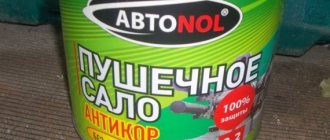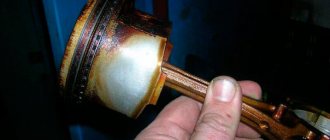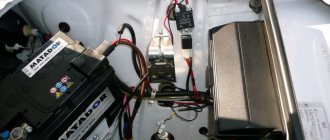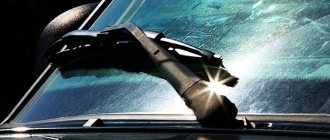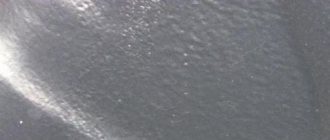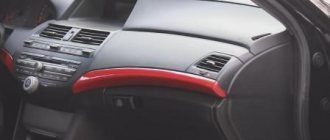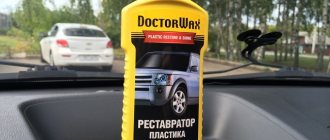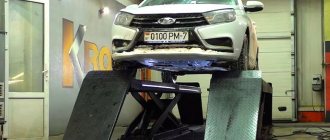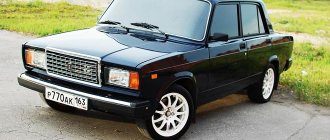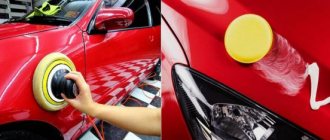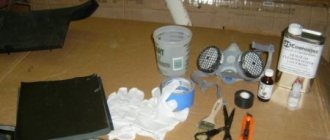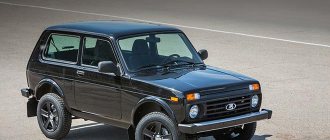Among motorists, cannon lard is very often used. Abroad, an analogue of such a product is sold under a specific brand. This product is used in many situations and is considered a completely budget-friendly substitute for most more expensive products that are used for anti-corrosion treatment of automotive equipment. It is known that gun lard was first used as a preservative lubricant for light and heavy weapons. It was also used to lubricate the barrels of artillery guns. Gun lard is produced in accordance with standards and belongs to the group of greases.
What is a pushsalo?
Gun lard is a plastic conservation lubricant intended for anti-corrosion treatment of metal surfaces during storage in warehouse conditions.
The lubricant originally developed for these purposes was named UNZ. It was created to protect artillery pieces.
In consistency and color, this lubricant actually resembled lard. This is where the popular name came from - cannon fat.
Then PVK lubricant entered mass production. Its composition was somewhat different from UNZ, but the basic properties and appearance were preserved.
The new lubricant was given the official name “Gun Lubricant” (GOST 19537-83 Gun Lubricant. Technical Conditions). People still call it “Cannon fat” or simply “pushsalo”.
Composition and characteristics
The components used largely determine the appearance and performance of any product. To better understand what pushsalo is, you must first consider its composition.
Mineral oil is used as a base fluid for lubricating PVC, and petrolatum, ceresin (about 5%) and its oxides are used as a thickener. To increase the protective properties, the composition of the cannon lard also includes an anti-corrosion additive.
The resulting grease ranges in color from light beige to brown, depending on the type of petrolatum thickener.
Gun oil works well in the temperature range from -50 to +50 ° C and is characterized by high water resistance.
The consistency varies quite a lot depending on the ambient temperature - from semi-liquid (at high temperatures), to viscous (at temperatures close to room temperature) and thick, almost solid (at temperatures from 10 ° C and below). Under normal conditions at room temperature, the composition looks like a plastic thick lubricant, reminiscent of lard.
At temperatures above +50 °C, the lubricant melts and easily drains from the treated surface. In southern regions, where the surface can become very hot in the sun, there are restrictions on the use of this composition.
Down to -50 °C, the lubricant has high stickiness, excellent adhesion to the surfaces being treated and retains excellent anti-corrosion properties. That is why PVK is widely used in middle and northern latitudes.
The stated shelf life of the conservation lubricant is 5 years, but in fact, when stored in a hermetically sealed container, even 10 years after the release date, cannon lard retains its properties.
The scope of problems that the push salo solves is small - the use of this composition is limited to the preservation of equipment and the protection of metal surfaces from corrosion. However, the inexpensive composition copes with these tasks so effectively that it has earned the recognition of tens of thousands of mechanics and car enthusiasts.
Cannon lard is used in its pure form or diluted with various oils, solvents, and other means.
The composition is especially often used for anti-corrosion treatment of cars - it is applied to the bottom, and hidden cavities are filled with it.
Useful tips
It is recommended to apply the composition not only to the arches, but also to the seams after welding. This way we preserve the places most susceptible to moisture accumulation. There are some more tips:
- If you use gasoline or other odorous compounds, you should not treat surfaces inside the car with gun fat. Otherwise, you will have to suffer for a long time from the unpleasant odor that will be absorbed into the upholstery.
- Although cannon fat can withstand +50 degrees, often already at +40 the mass begins to “slip”. Therefore, if you live in a region with a hot climate, it is recommended to add ceresin 67 or 80 (up to 5%) or a little ceresin oxide. This will prevent the composition from rolling off, and it will remain stable even at +50 degrees.
- If you plan to apply gun oil at an ambient temperature of +10 or below, then you need to be prepared for the composition to thicken too quickly. Therefore, it is very difficult to apply it with a brush.
- Wear protective gloves while working and do not allow gun grease to come into contact with your eyes or skin. It is recommended to carry out processing in a warm and well-ventilated area (especially if you are using gasoline).
Processing instructions
The process of treating a car with cannon fat is quite simple, but it is important to follow some safety requirements and also acquire a number of tools. To apply the substance to the car body you will need:. Cannon fat
In stores you can most often find this substance in containers from 2 to 5 liters. On average, it takes about 1 liter of substance to treat one car;
Cannon fat. In stores you can most often find this substance in containers from 2 to 5 liters. On average, it takes about 1 liter of substance to treat one car;
- Heat source. A regular electric stove, gas burner or something similar can be used here. A heat source is needed to heat the cannon fat;
- Tara. If you do not plan to use a full container of cannon lard, you will need to get a container in which you can heat the required amount of the substance;
- Degreaser. In this case, you can use regular white spirit;
- Application medium. This could be a brush, a paint gun or something similar;
- Sandpaper. If there are elements of corrosion on the car, you will need sandpaper to clean them off first.
Important: Before starting work, be sure to remove the fire extinguisher from the car and place it in a visible place. Since the work involves the use of heating elements, there is a risk of fire
Having prepared the necessary tools, you can proceed to work:
The first step is to heat the cannon fat to a liquid state. This substance melts at a temperature of about 90 degrees Celsius
It is recommended to use an electric stove to heat the substance, so as not to use an open fire, since the powder ignites easily; Please note: Before heating, it is recommended to add 10-20% of the volume of gasoline to the cannon lard in order to obtain a homogeneous mass during heating. It is also necessary to stir it constantly while heating the substance. You will also need to prepare the car for application of the substance.
To do this, it is recommended to remove all plastic elements that may interfere with the work. It will be necessary to clean the dirt from and dry the body parts to which the spray will be applied. If there are any signs of corrosion, remove them with sandpaper. When the body is prepared, degrease it using white spirit or another similar product;
Next, proceed directly to the process of applying cannon lard. You can use any convenient tools for this, but the easiest way to do the job is with a brush. When using a brush, use broad strokes to distribute the product evenly throughout the body.
You can apply cannon fat into hidden cavities using a syringe; Please note: If you use a sprayer to apply gun lard, you can add used machine oil to it while heating the substance to control the thickness
Once the substance is applied to the car, wait about an hour for it to dry before putting the plastic parts back on.
The main advantage of gun lard over other anti-corrosion mastics is its long service life. After treating the body with pushsal, at least 4 years will pass before you have to apply the substance again, while conventional mastics need to be replaced every 1.5-2 years.
There is also a drawback to cannon lard - its stickiness. Even after hardening, road dirt sticks quite strongly to the substance, but this problem can be solved by washing.
Features of cannon fat
Many people attribute the disadvantages of this type of processing to its sticky structure, which persists even after hardening. As a result, road dust can accumulate on parts. In fact, there is nothing wrong with this. Dirt can settle on any surface. To avoid the accumulation of dirt, you must not be lazy and wash off the dust from the bottom with each wash. The main advantage of the material is its long service life. Repeated treatment will need to be carried out after 5-6 years. At the same time, the most common mastics require updating after 2 years.
Conclusion
. Every driver understands the importance of protecting the car body from corrosion. In this regard, the question may arise of how to apply cannon lard. This substance perfectly protects parts from external influences. It's not difficult to use. To process the body you will need a minimum amount of time. When carrying out work, be sure to follow fire safety rules.
>
Requirements for anti-corrosion coating
The correct anticorrosive agent must have the following properties:
- Form an elastic film on a metal surface.
- Possess a high degree of adhesion - adhesion of various surfaces in solid or liquid form.
- Impregnate not only smooth surfaces, but also penetrate into cracks and depressions.
- Displace accumulated moisture.
- Wet the surface well.
- Should not dry out.
- Do not form cracks where water can penetrate.
- No special surface preparation is required.
- Be resistant to the mechanical effects of small particles rising from the road surface - gravel, sand, pebbles.
- Be resistant to temperature changes and maintain its characteristics at any time of the year.
The use of cannon tallow satisfies these requirements and creates reliable insulation from the environment. The composition of cannon lard is petroleum oil, which is thickened with petrolatum and ceresin. To ensure performance properties, an anti-corrosion additive is added.
The coating received its name due to the fact that it was first used to preserve artillery weapons, including guns.
Advantages
Main features of the substance:
- high degree of elasticity;
- ability to stay on the surface without rolling off during application and further use;
- lack of interaction with water, which allows it to be successfully used on the bottom of a car;
- temperature range of use – from minus 50° to plus 50°C;
- protection against corrosion when exposed to sea water and salt fog;
- Application area: ferrous and non-ferrous metal surfaces.
Visually it is a homogeneous ointment-like mass with a color ranging from yellow to light brown. Sold in metal cans or buckets of various capacities. Packaging starts from 1 kg.
The price of this type of anti-corrosion coating is very affordable. For comparison, the table shows the cost depending on volume and manufacturer.
Preparation
Before applying the coating, you should prepare everything you need. To carry out anti-corrosion treatment you will need:
- cannon fat in a jar or bucket;
- breeding agent;
- electric stove or hair dryer;
- paint brush;
- syringe.
We should especially talk about the breeding agent. There are several options for diluting cannon fat to a liquid state.
For this the following can be used:
- petrol;
- solvent;
- used oil;
- Movil;
- anti-corrosion agent like RUST STOP.
Each of them has its own disadvantages and advantages. The solvent will cost a little more. The processing properties depend on what kind of oil was originally used.
Anti-corrosion agent RUST STOP is one of the substances that successfully fights metal corrosion. Manufacturer: Canadian.
The advantage of RUST STOP is that it never freezes. Being in a semi-liquid state, this product fills all cracks and scratches on the metal surface without damaging the rubber parts. A layer of corrosion inhibitors reliably protects the surface from rust.
This anti-corrosion agent does not require particularly careful preparation of the surface to be treated - it can be applied over a slight layer of rust. As a result, the anti-corrosion treatment technology is significantly simplified and the time for the entire process is reduced. An additional bonus is that the manufacturer uses various fragrances, for example, cherry or strawberry.
Mode of application
First you need to prepare the car. It is necessary to remove all plastic parts that interfere with operation. Rinse the surfaces that will be protected. Remove traces of corrosion. Degrease the surface by wiping it with white spirit.
Then you should prepare the cannon fat. This work consists of heating it and bringing it to the consistency of thick sour cream. You can heat it on an electric stove, stirring constantly. It is also possible to use a hair dryer.
About two minutes after the end of heating, add a solvent or anti-corrosion agent to the melted lard in a ratio of 4:1. The solution is ready for use.
On large surfaces the solution is applied with a paint brush. Treating the underbody of a car with cannon fat requires that the car must be raised on jacks. It will be even more convenient to work while in the inspection hole.
It is wise to place a container below where the excess will drain or drip. Apply cannon lard to the surface using broad strokes. Each layer should be 0.3-0.4 mm thick. When it comes into contact with a cold car, the lard sets quickly. After hardening, you can apply another one on top.
Folk recipes for “anticorrosive” to protect the car body
With the arrival of spring, I started thinking about the condition of the car body after a city winter with dirt and reagents. The most vulnerable places for corrosion are wheel arches and sills. And the question became - what is the best way to update the protection of the arches, underbody and sills? I conducted a small survey on social networks and it turned out that many car owners use folk methods.
Folk remedies mean a combination of special products with oils or with each other, as well as products developed for other purposes (aviation, shipbuilding).
This option suits me, but now I need to find the best “ anticorrosive ” recipe.
After searching on various forums and sites, I decided to make a list of them: 1)
For the bottom.
“Cannon lard” + “Cordon” mastic in a 1:1 ratio and also add a little “Nigrol”. Everything is thoroughly mixed without heating and applied with a brush. 2)
Rubber-bitumen mastic and “Cannon lard” in proportions 4:1 and add grated “stearin candles” (200 grams per bucket).
All this is softened with the addition of gasoline and mixed. Apply with a brush in 2-3 layers. 3)
Rubber-bitumen mastic and “Cannon lard” in proportions 4:1 and add “Rust-Stop” for the bottom (2-3 liters per bucket).
Mix and apply with a brush in 2-3 layers. 4)
In place of the soil for the bottom, “Ship’s red lead” (2-3 kg) is mixed with drying oil.
Applies thoroughly with a brush and takes a long time to dry. 5)
“Aviation glue 88” is applied to a well-degreased surface.
6)
“Cannon lard” is mixed with “Rust-Stop B” in a ratio of 3:1, that is, for 2 kg of “lard” 650 ml of “Rust-Stop” for hidden cavities and 4:1 for the bottom.
“Rust-stop” is added to “cannon lard” preheated to a liquid state and mixed thoroughly. It is driven into hidden cavities using large medical syringes, and applied to other surfaces by rubbing in with a brush. For better processing, the metal is heated with an industrial hair dryer. 7)
“Gun lard” is mixed with preservative oil K-17 (TEP-15 “Nigrol”), with the addition of “dry fuel” as it works as a corrosion inhibitor. Preparation and application as in 6 , only without the “Rust-Stop”.
Do not forget about safety precautions, since most of these chemical compounds are flammable and toxic.
Before applying any anti-corrosion coating, you need to get rid of rust and apply it to areas of metal covered with primer.
Listed the most popular anticorrosive
which I found. Share your recipes in the comments or which of the listed ones you used, maybe I’ll add something new to the list from the comments. I wish everyone stainless cars!
Source
Types of preservative lubricants
To provide high-quality protection to the car body, special preservative lubricants are used. There are several main types of such materials:
- oils;
- film-forming inhibited lubricants;
- mastics;
- plastic lubricating compounds.
It is in the latter category that cannon fat belongs. To protect the body from harmful influences, the material should be applied to metal surfaces in a thin layer. The procedure has its own nuances and subtleties that must be observed. After applying cannon fat on the metal of the car body, a protective barrier is created that is not afraid of moisture, water, salts and various deposits. It is possible to achieve an excellent preservative effect. It's still not entirely clear what it is.
Anti-corrosion lubricants are called gun lard, which are very similar in appearance to ordinary lithol or paraffin. This is a budget material that has decent characteristics. It has the texture of an ointment and a characteristic yellow-brown color. The consistency is thick and very sticky. Because of this, you have to work extremely carefully with anti-corrosion lubricant. The basis for making pushsala is petroleum oil. It is thickened by adding petrolatum and ceresin. Manufacturers use additional additives and additives. With their help, it is possible to increase the efficiency of cannon lard and enhance its protective anti-corrosion properties. The set of additives depends on the specific manufacturer of the lubricant preservative material.
Types of funds
The set makes up an impressive list, but we will limit ourselves to the names of liquid funds. The list is:
- practice-tested mastics;
- inhibited compositions containing molecular inclusions of petroleum products that form protective films;
- oils that prevent oxygen from penetrating metal components and parts;
- lubricants with universal plastic properties.
The last resort is pushsalo. Practice has proven that pushsalo will be an effective talisman for body metal against rust. It is enough to apply a thin layer of a protective product on metal surfaces so that the feeling of fear for your car will forever disappear from the driver’s soul.
For example, the bottom of the car will become inert to the effects of rain, melt water, dust, impacts of small pebbles, and road salt from ice. That is, treatment with cannon fat will become a panacea for all negative road misfortunes.
Scope of application
Since gun lard has excellent anti-corrosion properties, there are no big questions regarding the scope of application of this lubricant. It is actively used in various household and economic industries, and is also regularly used when processing the body and underbody of vehicles. In general, cannon lard can be applied to various metal surfaces, regardless of shape, size or other parameters. The preservative properties of pushsal allow it to successfully exert its protective effect on the processed non-ferrous and ferrous types of metal. But it is important to consider that, like any other protective lubricant, with regular and direct exposure to sunlight, precipitation and temperature changes, the properties of gun fat will gradually fade away. It is necessary to periodically renew the protective layer to prevent the possible formation and spread of rust on metal surfaces.
Gun lard has decent characteristics, thanks to which it is so often used for working with various types of metals. Depending on operating conditions, the intensity of metal wear and external influences, a protective coating made of pushsala can last 3-10 years without losing its effectiveness. The operating temperature range for this lubricant is from -50 to +50 degrees Celsius. This makes it possible to use cannon fat in almost all regions. Only with incorrect application or with overly aggressive action can cracks appear on the surface treated with lard. It is worth adding that the material is characterized by the property of not dissolving in water. This allows you to wash your car multiple times, even with a powerful jet of water. After removing the contaminants, the gun fat will still remain on the surface of the metal and will not lose its protective properties.
pros
- has high adhesion to metal;
- does not dissolve in water;
- remains solid and elastic in the range from –50 o C to +50 o C;
- has a low price;
- thins for ease of application in several ways.
But motorists were of little interest in cannon fat for its original purpose, because a vehicle is not a stationary gun or tank mothballed at a storage base, but a mobile object in operation. Therefore, strong bitumen, epoxy, plastisol and other mastics began to be used to protect open surfaces (facing the road), and push salo was used to preserve closed cavities.
To blow into the body cavities with mixtures based on pushsala, the composition must be heated to 90 degrees. Craftsmen use a variety of devices.
The technology for using this wonderful product was formed in cooperative garages, but no one would dare call it artisanal. After all, now unknown innovators took into account all the subtleties of anti-corrosion control. Such as: the need to deliver anticorrosive material to the narrowest and most inaccessible corners of the body, right up to the welding seams, the possible presence of moisture inside the structures, the need to distribute the drug in an even layer without excessive accumulation in certain places.
Therefore, today cannon lard is used for blowing, firstly, in a heated state, and secondly, not in its pure form, but as part of mixtures. To liquefy and better atomize, the push salo is flavored with “working off”, to give better penetrating properties, the industrial preparation “Movil” is added, for elasticity - rope lubricant, to accelerate liquefaction - diesel fuel or solvent... The proportions of the master are not kept secret, but they often vary depending on the client's capabilities.
The photo from the endoscope shows how to properly blow anticorrosive agent (of any type) into closed body cavities: the drug (yellow-brown) lies evenly on all surfaces.
Before blowing, the mixture is heated to 90 o C. To do this, a durable container heated over a fire or blowtorch is built into the high-pressure air line between the compressor and the gun.
Instructions for correct application
To properly process a car, you need to prepare cannon lard of the selected brand in a volume of 1-2 liters per car, as well as a set of consumables and tools:
- heat source - gas burner, electric stove, hair dryer, any other for heating lard;
- a container for dispensing lubricant from a large canister, which does not make sense to heat;
- degreaser – white spirit, acetone;
- brush, spray gun for applying lard;
- sandpaper if there are already traces of rust on the surface of the parts (needed to remove them).
Since solvent and spray are flammable, and heating will be generated during the work, it is better to place a fire extinguisher near you to be on the safe side.
Preparatory work
As preparation measures, you need to put in order all the details that will be processed:
- remove plastic elements;
- wash the body, dry it, degrease it;
- remove existing rust.
In order for the lard to acquire the desired consistency, it must be diluted to a liquid state, then heated. Usually the lubricant is diluted with gasoline, which can be poured in an amount of 10-20% of the total mass to form a liquid, homogeneous product. Afterwards, the cannon fat is heated to +90 degrees, when the process of melting begins. The fire must be slow to avoid dangerous consequences. The mass is constantly stirred when heated, otherwise it may separate. If you plan to spray the composition with a spray gun, it is recommended to add a little motor oil to it.
Applying gun lard
A large container is placed on the floor of the inspection pit so that the remaining lard flows into it and not onto the floor. If you use a brush for application, try to make wide strokes, which will help to evenly distribute the fluff over the surface of the part. A layer thickness of 0.3-0.4 mm is sufficient, and if the layer is too thin, go over the base again. The easiest way to pour material into thresholds, door openings, and technological holes is with a syringe. After applying the composition proceed as follows:
- dry the car naturally for 1-2 hours;
- return all removed parts to their place;
- start using the car.
Places for processing
Usually, preservation is carried out in those places where moisture tends to accumulate. These include welds, joints of elements, arches, various cavities and voids. Push salo is not used in the car interior, because it has an unpleasant odor.
How to wash off gun fat
Cannon lard is not washed off with water because it does not dissolve in it. However, there are situations when there is a need to remove it from the metal surface. If the drying time of the composition has not yet ended, you can wipe it off with a rag: this is usually required if the application is careless. After mechanically removing most of the grease, the rest can be washed with laundry soap.
To remove unnecessary smears of dried lard, it is recommended to use acetone or any other solvent. But the latter are capable of dissolving the paintwork itself, so you must act with extreme caution. Another option for cleaning the surface from pushsal is to combine kerosene and gasoline (60% and 40%), lubricate the metal with this product, then wipe off the remaining grease with a rag and soap.
Water heated to +50...+60 degrees will also help remove grease stains. The hot liquid warms up the lard, it melts and rubs off well. In winter, this method will be useless. To enhance the effect, it is recommended to drop ammonia into the water.
FakeHeader
Comments 59
I once had the opportunity to saw up a donor, whose cavities were filled with pushsal, and layers of mastic were falling off from its belly. The fluff in the cavities only held on to the iron in places, but otherwise there was water and rye between it and the iron, with a little bit of stratum rye. Naturally, about 5 years before it came to me as an emergency cut - it was cooked in a checkerboard pattern. In general, I don’t like either mastic or fluff (the latter disappears somewhere from the floors under the rugs, by the way, the question is where?), but I love nigrol. And the combination of mastic with pushsal makes me really nervous, because every year my neighbor, the car dealer, pings me with his wonderful plans to mix it up and ask him to either paint the pulik or weld a piece of iron into the arch.
I treated it with this mixture - everything was OK
5050 heated on the stove until it became water and stirred
Forget all the mastics for your car if they contain bitumen. As a rule, 25 years ago, push-fat was heated with working off and sprayed (a copper tube, the end is flattened with the hole of the drill, under pressure, like a brush, you spray) hidden places. There is one minus: it flows into heat after 35°
ok everything will stick
This is exactly the article above my comment. That's her. And whether to process it or not, as they write even above, is your choice. Previously, cars were anti-crawled conscientiously and for years, but now it’s not for me to tell you. So if you love and take care of the car, then it won’t last even a year. Advice. Maj.
Dinitrol is not dinitrol, but read it here please! www.drive2.ru/l/472040134087278916/ Your own car, this was not done at a service center. And if you’re interested, I’ll also write an article about growth. It's up to you to decide. And mastic probably won’t mix with pushsal. I poured pushsolo-movil-nigrol-urotropine into the rapids, preheating it on the fire. But the mastic does not heat up on the fire (I tried it), it is heated with gasoline. Good luck with your selection and processing.
You are mistaken, the mastic mixes perfectly with lard, heats up for about 20-25 minutes on an electric stove and is applied, adhesion is excellent
I won't argue.
Use the transmission mastic to loosen it and it's fine. I think the push salo will also work. Movil only sills and side members, the doors will stink. Fill the doors with some kind of smelly oil. And Movil is a good Movil-NN 5l canister, fill it with nigrol and pour it into the sills and side members.
Movil will smell 100%
Normal scheme. Apply and don’t worry. It is only advisable to make at least 2 passes, with overnight drying between them.
Purchase and storage
The cost of cannon fat is low. Usually a small jar of 4-5 kg costs no more than 500 rubles, although small packages are also available for sale. The price of a 40 kg container will be 2,500 rubles, which is very profitable for professionals. Previously, it was possible to purchase the product in military stores. Now it is sold as freely as Movil, nigrol, solid oil and motor oils. To purchase, you should contact any car store that sells similar products. When choosing, it is better to give preference to brands that produce products in accordance with GOST, rather than in accordance with specifications - such products are of higher quality.
The shelf life of cannon lard is very long. If the jar is tightly sealed, it is 5-10 years depending on the manufacturer's specific instructions. However, expired material should not be thrown away either. If the temperature regime remained more or less stable, the lard did not undergo repeated heating and defrosting, it will last for 20 years without losing its properties.
Price
On average, the price of PVC lubricant is relatively low. For example, for a 39-kilogram drum of cannon fat you will have to pay about 2.5 thousand rubles. True, this amount of lubricant can be used to treat at least a couple of truck tractors, not to mention passenger cars. There are smaller containers - the cost for them varies from 400 to 1.5 thousand rubles, depending on the manufacturer and the volume of the drum itself.
Feedback on pushsal treatment
The price of cannon fat in the regions of the country ranges from 100...180 rubles. for 1 kg, which predetermines its widespread use. Car owners point out the following advantages of the product:
- High elasticity of the treated surface.
- Resistance to water and aqueous solutions.
- Efficient over a wide temperature range.
Many reviews note that the durability of coatings using gun fat increases significantly if Canadian-made Rust Stop anticorrosive agent is added to the mixture: the antioxidant resistance of parts increases. In order to increase heat resistance at high operating temperatures, some car owners recommend adding 33K-3u conservation lubricant to the pushsal.
